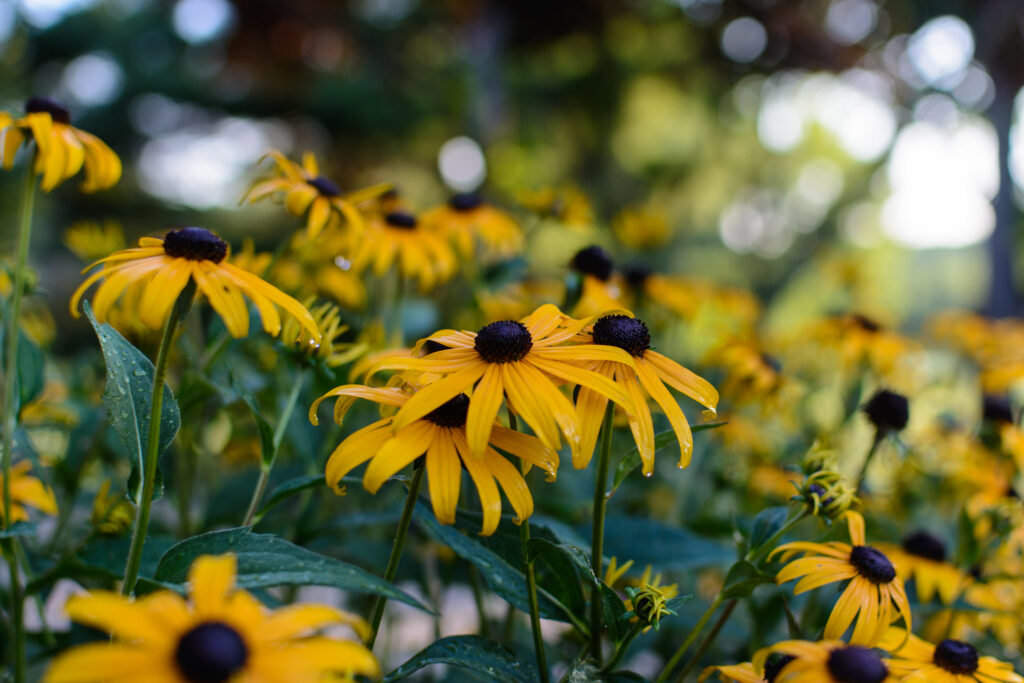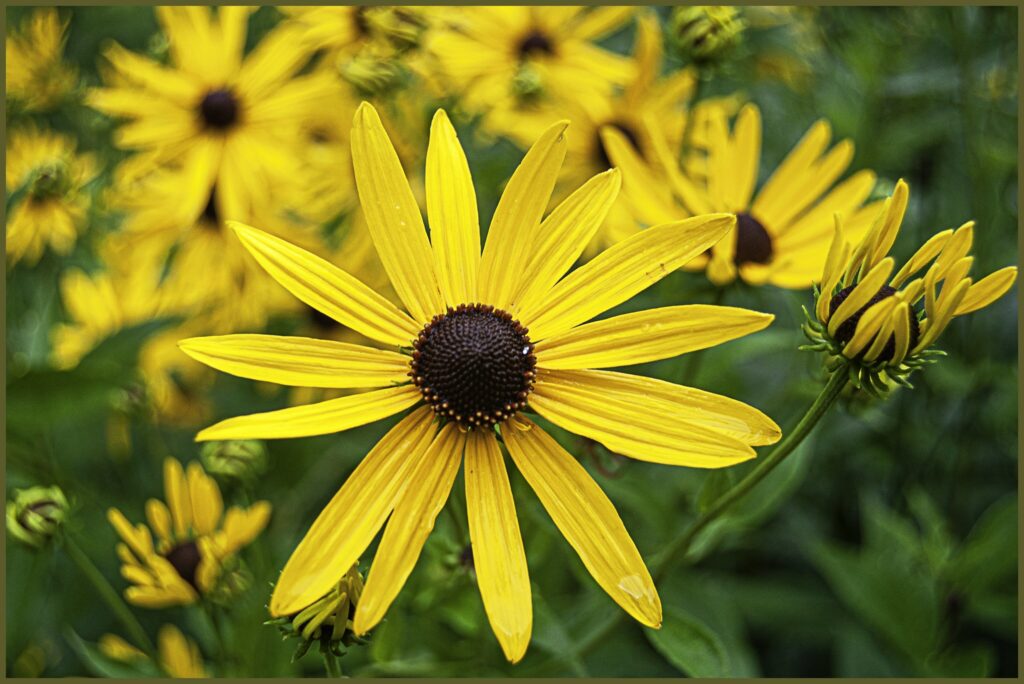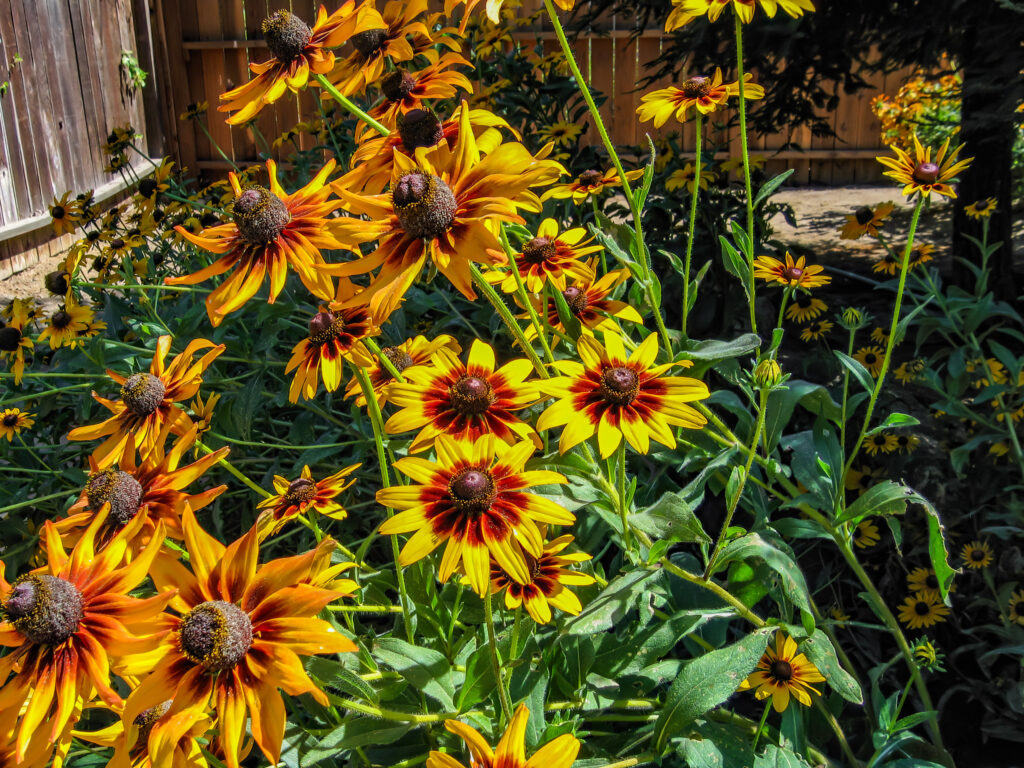Black-Eyed Susans are a beautiful, easy-to-grow flower in the Asteraceae family. They tend to spread quickly. Black-eyed susans grow everywhere on the east coast, from Newfoundland to Florida. They have adapted well to the West Coast as well, and are grown from British Columbia to Baja California and throughout the Midwest. They were used as an herbal medicine for treating colds and infections by Native Americans and were introduced to European gardens by the 1700s.

They are generally grown as ornamental flowers. They are quite pretty, with characteristic black orbs at the center, and yellow petals spreading out around it. There are a few varieties, even some with different colored flowers. Black-eyed Susans vary in size, anywhere from one foot tall to three feet tall. The smaller flowers, about 3-4 inches in diameter, are often the best for growing in containers since these are deep-rooted plants. A few are quite large, like the Indian Summer, which is often in the three-foot height range, and the flowers are up to 9 inches across! They can be used to brighten up the borders of your garden in the summer, or as a focus in a flower bed.
- Rudbeckia hirta (biennial), Rudbeckia fulgida (perennial)
- Grown as an annual, a biennial, and a perennial.
- Full sun
- Fertile, well-drained neutral soil (pH 6.8 to 7.7)
- Start seeds in the fall or spring
- Plant in the garden
- Plant 6-12″ apart (8″ apart is a good rule of thumb for smaller varieties)
- Plant 18-24″ apart for the larger perennials.
- Growing in containers:
Start single plants in a large pot, at least one gallon in size, larger is better
Ensure good drainage
- Water new plants regularly, when the soil is dry. Established flowers do not need excessive watering.
- Climate Zones 4-9 (Some varieties are hardy in zone 3)
There are two main groups of Black-eyed Susans. The biennial types are Rudbeckia hirta and are usually smaller. These are technically short-lived perennials, rather than biennials, but it’s easier to think of them as biennials. They are very often grown as annuals. The longer-lived perennial types are Rudbeckia fulgida, and these are usually bigger. Some varieties can last up to 15 years. There are also a few related similar plants. The first is Rudbeckia laciniata, usually called “Cutleaf Coneflower” as they have a multi-colored cone instead of the black orb typical to the Black-eyed Susans. Another is Rudbeckia subtomentosa, “Sweet Coneflower.” The Sweet Coneflower has narrower petals than Black-eyed Susans. For both, planting and care are just like the perennial types of Black-Eyed Susans. As a side note, the Black-Eyed Susan Vine, Thunbergia alata, is a non-related vining plant with similar looking flowers that grow in warmer subtropical and tropical climates.
Planting Black-Eyed Susans
Black-eyed Susans are commonly grown from seedlings but can also be started directly in the garden from seed. Timing is important for planting. Black-eyed Susans should be planted in the garden in spring after the last frost, or in autumn at least six weeks before the first frost. It’s often best to plant in the fall, which allows the plant to overwinter, and this will produce a steady supply of flowers the following summer. They can be grown as annuals, but for this, it’s best to start the biennial varieties inside about six weeks before the last frost, to allow for additional growth, then transplant them to the garden after the last frost. This allows the plant time enough to mature for blooming the first year.

Plant seeds or seedlings for smaller flowers about 8 inches apart, but the larger varieties need more room. For these, 18 inches apart is a good distance, since the root systems can get quite large. Choose a spot that gets full sun if you can. Dig a hole somewhat larger than the plant, and fill in with good garden dirt. They grow best in well-drained soil. The larger plants can be planted closer together. If so, the closeness will reduce the quick spread of the plant over the years, but it may encourage some diseases and pests. It’s best to water them regularly, but water at ground level rather than by spraying water over the top of the plants.
Growing Conditions for Black-Eyed Susans
These flowers are very resilient! They can withstand hot and cold temperatures, as long as it’s warmer than arctic or sub-arctic, and cooler than tropical. Seedlings need warmer temperatures until they get a bit of growth, and get some roots established. Once they are started they do well over-wintering in sub-zero temperatures and will come right back in the spring. They do love light! Full sun is important. They can survive in some slight shade, but the more light the better.
These flowers are perfect for containers also. They do need big pots! The root systems are quite big, and they need enough space. For the smaller flowers, a gallon-sized pot will do fine, but bigger is better. It’s easiest to grow the smaller types in pots, as it gives you the ability to control the soil, water, and light easily. Fertilization is not generally needed for this versatile flower. Keep the soil moist by watering regularly (even daily). Ensure that the pots drain very well and that the soil is never soggy, just moist. The larger perennials will do well in pots also, but the pots need to be even larger. The soil in pots can get colder than ground soil in the winter. In the coldest climates, it may be best to move them indoors in the winter, to keep the soil from freezing. Usually, a basement or an unheated garage will be fine for this.

Black-Eyed Susan Companion Planting
Black-eyed Susans are often planted as companion plants for melons, lavender, echinacea, and sage. Lavender and sage are both good herbs, and both are good deterrents to pests like aphids, mosquitos, moths, and fleas and will attract bees. The Michaelmas Daisy might be the best companion plant for this Black-eyed Susans, visually, because they have similar soil and light requirements, and while the yellow Black-eyed Susans bloom only until late summer, these purple daisies bloom starting in late summer and through the fall.
Black-Eyed Susan Pests and Diseases
One primary pest that troubles this plant is aphids. Companion plants can help with prevention, and they can be sprayed directly off the plant with a hose. Sawflies, a type of wasp, is also a problem for Black-eyed Susans, as they are with fruit trees. Slugs and snails can also be a problem, but they can be removed by hand, and scattering some diatomaceous earth around the garden bed will keep them away. They are also subject to some diseases, like powdery mildew, downy mildew, and leaf spot, as well as Verticillium wilt. These diseases can be prevented by correctly spacing the plants, and ensuring to water is regularly at ground level rather than by watering from above with a sprinkler. Antifungal agents can be used to treat fungal infections like powdery mildew, and infected leaves can be pruned off. Mildewed plants can be treated with a neem oil spray sometimes, and it’s good to be aware that neem oil can also be a preventive for aphids.
This plant will reseed itself naturally, and many gardeners let this happen to keep their beds alive. Seeds can be harvested as well, in the fall. Once the flowers turn brown, pluck off the dry seed heads. Let them sit for a few days, or a week, then remove the husks and separate the seeds from the seed heads. Let them dry thoroughly, and store them until you need them, either in the late fall or spring planting! It’s easy to love this low-maintenance beautiful flower, either for your garden or for pots on your porch! Plant Black-Eyed Susans in your dream garden, made easy with the use of Garden Savvy’s garden planner Hortisketch.

Contact Author
 info@gardensavvy.com
info@gardensavvy.com Recent Posts
- Smart Gardening: How Technology Is Revolutionizing Horticulture
- Understanding Gardening Zones: What You Need to Know
- The Right Tools For Your Gardening And Landscaping Needs
- Maximizing Your Harvest: Square Foot Gardening Chart for Beginners
- Holiday Garden Scents: Plants for Natural Aromatherapy in Your Home






